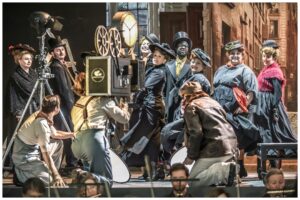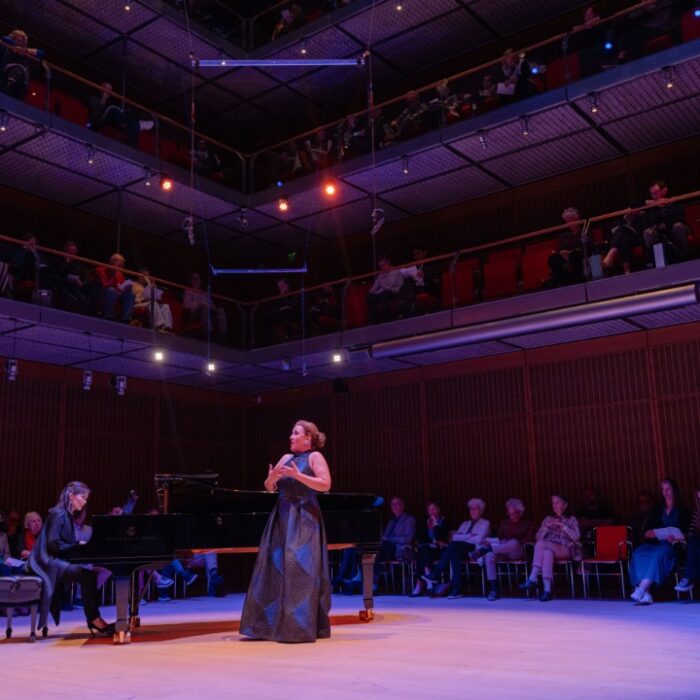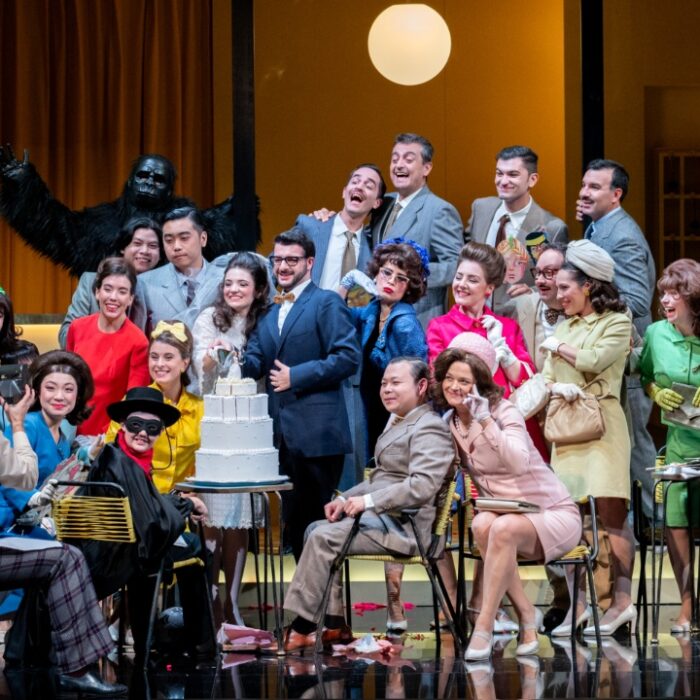
Opera Holland Park 2023 Review: La bohème
Natascha Metherell’s Cinematic Angle Sometimes Loses Focus
By Benjamin Poore(Photo: Opera Holland Park 2023 © Craig Fuller)
Part of “La bohème’s” appeal is surely in its cinematic quality. Puccini’s score does so much meticulous work that directors sometimes feel that they have little to do other than show the singers to the stage – and ensure they take the right cues from the orchestra. There are sudden close-ups and pans; a sweeping tableau suddenly zooms in on a single face, before dollying back again.
So why not set the thing on a film set? This is the premise of Natascha Metherell’s new production of the stalwart for Opera Holland Park, conducted by George Jackson, which frames the story as that of a quartet of filmmakers making a Fellini-era movie about “La Vie Parisienne.”
The Magic of Film
It’s a strong idea in principle: another part of the opera’s appeal, despite it being the textbook example of so-called verismo realism in the form, is the strange sense of dreamy unreality that hangs over the piece too, with its extravagant spectacle and melodramatic gestures. It was always a Paris of the mind after all – the city Puccini depicted had been literally demolished by Haussmann decades earlier; in Murger’s novella they aren’t even really poor – just posh boys doing poverty tourism.
Directors have approached this in different ways: Claus Guth’s turned it into a “Solaris”-style delusion for the Opéra National de Paris; Floris Visser’s production for Glyndebourne last year took on an hallucinatory quality, literalizing the figure of Death; Barrie Kosky at the Komische Oper allegorized the piece through the photographic art contemporary to Puccini, bringing into view the artifice inherent to the piece and its central quartet of creatives.
How does Metherell fare? Mixed results overall, though it’s undoubtedly clever. Text and setting are treated loosely and suggestively. There’s no garret until the final act. Marcello is a set designer rather than painter; his Pharaoh and Red Sea are box models for a sword-and-sandals epic; Rodolfo is a screenwriter, and Mimi a girl from the costume department. Their problem is less poverty than frustration with the production Manager – a finely-honed performance from Henry Grant Kerswell rolls Benoît and Alcindoro into one.
The Act two spectacular cuts between the staff canteen – Café Momus – and crowd scenes from the film. Here the choreography from chorus and cast is spectacular, in a wildly inventive dovetailing of the real and fake worlds summoned onstage. It’s an imaginative restaging of a well-worn sequence that reconciles the fantastic elements of the street scene with the ordinariness of people sitting down to eat and drink in a cafe – undoubtedly the highlight of the production.
The whole thing undoubtedly looks wonderful – Madeleine Boyd’s sets and costumes are wonderfully evocative instances of period detail and mean the eye is never bored, with a very busy chorus getting in and out of costume (presumably for another show), putting on makeup, and so on. But the splendor sometimes makes scenes meant as close-up display in widescreen, distorting the emotional and dramatic aspect ratio. Extras bustling about during the big Act one love scene has a certain cooling, ironic, effect – the moonlight that catches them is just a prop being tested; the snow is just as fake – which is intriguing but leaves the audience dangling. One senses the intellectual acuity of the production would register better in a traditional theater rather than the more open-plan, festival feel of Opera Holland Park’s big tent. As the set tightens for the final act, so does the emotional screw – though it still feels a little far away.
Stumbling Stagecraft
Sometimes the stagecraft stumbles. Opera Holland Park still makes use of an apron folded round the orchestra, which suits interior and intimate scenes, and which wasn’t used in either the opening scene nor the finale – robbing both of bonhomie and tragedy respectively. Likewise, Act three ends with Marcello and Musetta downstage, exchanging their barbs, with poor Rodolfo and Mimi occluded upstage, swapping their heartfelt farewells – it feels like an unforced error.
So too the strange interpellation of crackling recording Edith Piaf at the top of the show, which Musetta sang along to, as if to establish her as a singer, and the atmosphere of the piece. But surely there are easier ways – not least given the vibrancy of the design. It sucked some of the energy out of Puccini’s breakneck opening.
More successful, though, was a parallel intervention between Acts three and four: Philip Costovski’s Parpignol – now out of costume, a budding singer, evidently – performed Puccini’s 1917 song “Morire?”accompanied by piano; you may know a different version of it from “La Rondine,” but the title says it all. It was a haunting moment of peremptory tragedy between the brusque gestures that close and open the successive parts.
Star of the Show & Mixed Affairs
Katie Bird’s Mimì is undoubtedly the star of the show. A gossamer top C closed Act one, gleaming like moonlight. Portamento throughout was elegant, adding the most subtle lyrical polish to finely-wrought phrases. Her ‘Mi chiamano Mimì’ had a glorious evenness. The carefully-shaded dynamics of the final scene were a wonder too – no small feat in the cavernous space – with the timbre growing ever more shrouded.
Adam Gilbert’s Rodolfo was a more mixed affair. He walks the walk well, and comes off as an impetuous – arrogant even – film-industry hothead, with a tender, charismatic side. Vocally, though, he took time to settle and was rather pinched and tinny in the upper register. Everything was in tune, but it never quite bloomed as luxuriously as Bird’s Mimì, ‘O soave fanciulla’ feeling rather reedy and forced.
Ross Ramgobin made a fine foil as Marcello, his voice having grown happily into sumptuous late Romantic roles. In Act two the climax of Musetta’s waltz was all heroic bronze and ardor, and he remained ever nimble during Puccini’s incessant patter. Elizabeth Karani sang his impetuous paramour with zip and sparkle. The brightness was dialed all the way in her silvery flourishes; the opening phrase of her waltz was self-indulgently lustrous, with some wonderfully in-character exaggerations in the phrasing; one couldn’t help but be charmed, and she certainly carried the allusion to Piaf into her own vocal stylings.
The Act three comic business – record-smashing and all – drew out the best in all four, with Barnaby Rea’s Colline and Harry Thatcher’s Schaunard having a whale of a time; they were similarly commanding and engaging as they choreographed the action of Act two. Rea’s ‘Vecchia zimarra’ was doleful and laconic – the aria can sometimes come over as oddly pantomimic or silly – but carefully-nurtured legato lines and the oaky colors of Rea’s instrument gave it an understated gravitas. Thatcher’s Schaunard blusters at first, giving way to a s tender and naïve soul in the final Act, standing vigil as the couple share their final moments together.
George Jackson led the City of London Sinfonia from the pit in a precise account of the score that took a while to come out of its shell. The complex air traffic control of ACt one was exact but cautious, and it was in Act two that the piece’s energies really started to bubble more freely with the orchestra. His finest work came in Act four, both in the brilliantly-coloured dance sequences and then the weepy luxury of Mimì’s death scene. The very final bars saw the music dissolve – something perhaps helped by the reduced forces entailed in this version, which sometimes wanted for a bit more heft. Musically, it comes off very well indeed; the production probably wants some fine-tuning in revival – but it is a thought-provoking feat nonetheless.


